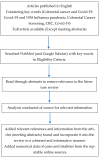Colorectal Cancer Screening: Impact of COVID-19 Pandemic and Possible Consequences
- PMID: 34947828
- PMCID: PMC8707125
- DOI: 10.3390/life11121297
Colorectal Cancer Screening: Impact of COVID-19 Pandemic and Possible Consequences
Abstract
Colonoscopy procedure has been the key screening method to detect colorectal cancer (CRC). As a fatal disease, CRC needs early detection. The COVID-19 pandemic caused screening tests (colonoscopy) to be halted and delayed. As a result, there could be dire consequences such as later-stage or missed diagnosis or greater mortality. This report will analyze scientific literature pertaining to interrupted CRC screenings due to COVID-19 while drawing historical parallels from the 1918 flu pandemic. We conducted literature searches in the PubMed database as well as in Google Scholar. One of the main lessons learned from the 1918 flu pandemic was to employ social distancing to stop the spread of the virus. So, the global response at the start and peak of the COVID-19 pandemic was decreased hospital visits for any non-emergency cases. That led to a halt and delays in cancer (including CRC) screenings. The Medical community predicted this lag will cause more CRC cases and deaths in the future. However, reorganizing and changing screening method strategies were helpful during the ongoing pandemic. In conclusion, COVID-19 greatly affected CRC screening, including how we view the future of CRC screening. We can learn from this prospect to better prepare for future pandemics or other public health crises.
Keywords: COVID-19; CRC screening; Spanish flu; colorectal cancer; pandemic.
Conflict of interest statement
The authors declare no conflict of interest.
Figures
References
-
- 1918 Pandemic (H1N1 Virus). Centers for Disease Control and Prevention Website. [(accessed on 26 October 2021)]; Available online: https://www.cdc.gov/flu/pandemic-resources/1918-pandemic-h1n1.html.
-
- Overview of Testing for SARS-CoV-2 (COVID-19) [(accessed on 25 October 2021)]; cdc.gov. Updated 17 March 2021. Available online: https://www.cdc.gov/coronavirus/2019-ncov/hcp/testing-overview.html#Intr....
-
- COVID-19 Dashboard by the Center for Systems Science and Engineering (CSSE) at Johns Hopkins University (JHU) [(accessed on 21 November 2021)]. coro-navirus.jhu.edu. Available online: https://coronavirus.jhu.edu/map.html.
Publication types
LinkOut - more resources
Full Text Sources
Research Materials


